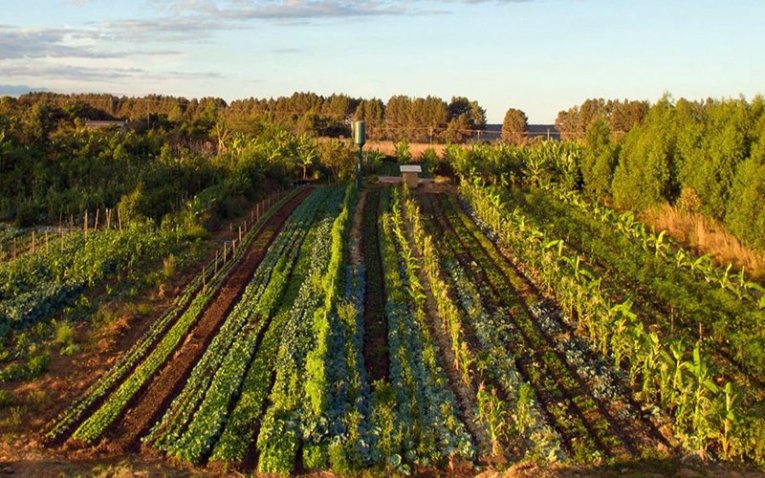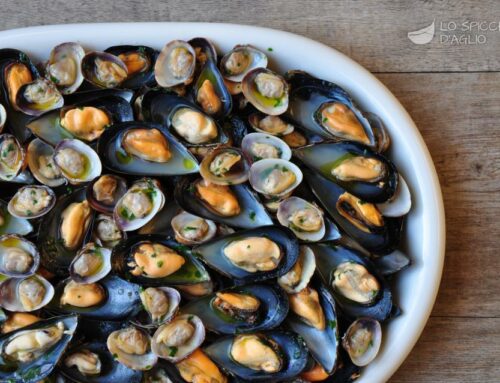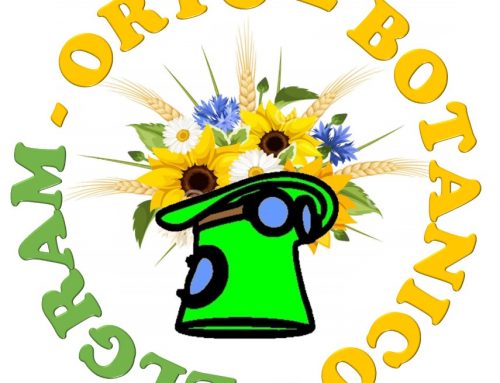Pubblicato online in italiano per la prima volta, il saggio di Patrick Whitefield che ha sollevato l’attenzione sul potenziale dei sistemi alimentari in permacultura. Oggi celebriamo il suo spirito pionieristico e la sua dedizione alla permacultura.
Ma la permacultura può sfamare il mondo? Be’, direi di sì.
Ma che io abbia ragione o torto, una cosa è certa: l’agricoltura convenzionale non potrà sfamarlo ancora per molto. Essa è basata su un flusso a senso unico di risorse non rinnovabili e sta crollando sia dal punto di vista di ciò che vi immettiamo, gli input, che di quello che essa produce, gli output.
Gli output includono il degrado del suolo. Negli USA, uno dei maggiori esportatori di cibo del mondo, un terzo del suolo coltivabile presente quando vi giunsero gli europei, è stato eroso, e la perdita va avanti 17 volte più veloce di quanto occorra al suolo per formarsi. Continuare a coltivare con il metodo attuale significa cercare di sfamare sempre più persone con sempre meno terra fertile. È impossibile.
Dal lato degli input, la maggior parte del flusso di sostanze non rinnovabili va a finire nei fertilizzanti chimici. Uno dei tre grandi nutrienti forniti dai fertilizzanti è il fosforo. Il fosforo viene estratto da depositi naturali di fosfato roccioso in alcune zone del pianeta e, come il petrolio, si sta avvicinando al picco produttivo; presto la produzione mondiale non riuscirà più a soddisfare la domanda. L’azoto è richiesto in misura anche maggiore del fosforo e viene estratto dall’aria mediante un processo che utilizza una enorme quantità di carburanti fossili. Visto che il prezzo dell’energia è cresciuto nell’ultimo decennio, i contadini hanno visto il prezzo dei fertilizzanti più che raddoppiare. Ed è solo l’inizio.
Doppia coltivazione
I coltivatori bio affrontano questi problemi con la rotazione delle colture, che in Gran Bretagna significa alternare qualche anno di cereali e qualche anno di erbe miste e trifoglio, sui cui pascolano mucche e pecore. Questo riduce l’erosione, anche se non la elimina, e l’azoto è procurato dal trifoglio, che lo “fissa” prendendolo dall’atmosfera. Il lato negativo è che i coltivatori bio coltivano in una parte della fattoria e nello stesso periodo soltanto cereali. La prateria temporanea produce cibo sotto forma di carne e latte ma è una quantità molto inferiore a quella che si otterrebbe dai cereali. È questo, più che la minor resa di cereali organici di per sé, a ridurre la resa della fattoria biologica in confronto a quelle convenzionali, che non praticano la rotazione.
La permacultura va un passo oltre coltivando un misto di trifoglio e cereali nello stesso campo contemporaneamente. È una tecnica nota come “bicropping” [doppia coltura NdT] e aiuta a coltivare ogni anno i cereali, e altre colture destinate al consumo umano. La resa dei cereali è potenzialmente un po’ inferiore che in assenza di trifoglio, ma quest’ultimo può nutrire gli animali.
Il trifoglio è presente come sottobosco permanente, così il suolo non mai nudo e l’erosione è eliminata. La copertura permanente della terra e la mancanza di aratura creano l’habitat ideale per alcuni funghi, che in uno scambio simbiotico, procura fosforo alle coltivazioni. Intanto il trifoglio provvede al fabbisogno di azoto esattamente dove serve. Senza contare le ripercussioni positive sulle erbacce, i parassiti, le malattie e l’uso del carburante. 1
Stacking
Un fattore che aiuta la doppia coltivazione a funzionare meglio è la differenza nella struttura di crescita delle due piante. L’alto cereale e il basso trifoglio creano due livelli distinti di vegetazione e questo riduce la competizione fra di loro. Chiamiamo questa differenziazione “stacking” .
La più incredibile forma di stacking è l’agroforestale, in cui alberi sono mescolati a piante erbacee, inclusi cereali, ortaggi o praterie. Ne è un esempio un frutteto tradizionale di mele misto a pascolo. La differenza di altezza tra i due elementi significa che la competizione fra loro è irrisoria. Tanto è vero che quando gli alberi sono ancora giovani non c’è nessuna perdita di raccolto nello strato erbaceo
Anche i cicli annuali dei due componenti sono diversi. Prendiamo ad esempio la combinazione di grano e noci. Il grano si semina in autunno e il suo massimo sviluppo è in questo periodo e poi di nuovo in primavera prima che spuntino le foglie dei noci. Al polo opposto della stagione, i noci restano in foglia per due mesi abbondanti dopo che il grano da verde è diventato dorato. Sono queste foglie verdi a produrre cibo e sono presenti in questa mistura per molto più tempo nel corso dell’anno di quanto entrambe le colture ci sarebbero state se cresciute da sole.
Policoltura
Doppia coltivazione e agroforestale sono solo due esempi di come sia possibile combinare le piante. Ce ne sono molti altri e, se la combinazione è frutto di un buon design, la resa complessiva sarà più grande che coltivando i singoli elementi separatamente. Questo vuol dire che possiamo coltivare più cibo in meno terra. La quantità di componenti può variare da due a diverse centinaia, come nei forest garden. Misture come queste sono chiamate policolture, in opposizione alle monocolture in cui si coltiva una sola pianta.
Il canneto & i bassopiani – Una parabola
Di tutti gli ecosistemi che possono crescere nella fascia temperata nessuno produce più materia vivente per metro quadrato di un canneto. Avendo risolto il problema di come crescere sul suolo acquitrinoso, le canne dispongono di abbondanza di risorse a propria disposizione. Crescono in acque ferme e poco profonde e così non hanno mai bisogno di altra umidità nella stagione della crescita. I nutrienti di origine vegetale vengono trasportati dall’acqua che li raccoglie nei dintorni e li porta nelle zone più basse, in modo che le canne si godano un rifornimento di nutrienti che non ha eguali nel mondo naturale. Esse crescono così tanto che sopprimono tutte le altre piante, motivo per cui i canneti sono monocolture naturali.
Al contrario i bassopiani calcarei e gessosi, drenano l’acqua assai bene. Qualsiasi periodo senza piogge comporta uno stress in termini di umidità. Il suolo è naturalmente sottile e la sua fornitura di nutrienti si è esaurita in generazioni di pascolo. In tali condizioni nessuna pianta può crescere vigorosa abbastanza da dominare le altre, sicché il livello di diversità è fenomenale. La produttività viene mantenuta da ogni pianta facendo qualcosa di leggermente diverso: alte o basse, con radici profonde o superficiali, precoci o tardive, azoto-fissatrici e così via. In questo modo fanno un uso più completo delle modeste risorse disponibili.
Nell’era dei carburanti fossili abbiamo potuto coltivare come fanno i canneti.
Abbiamo creato una serie di monocolture con livelli anormali di nutrienti e altre risorse. Ma in futuro non sarà possibile e la nostra via per la produttività sarà prendere il modello dei bassipiani e, che massimizzano l’uso delle poche risorse disponibili attraverso la biodiversità.
Scala ridotta
La diversità è più facile da ottenere su scala ridotta che vasta, in un giardino domestico che in una fattoria di migliaia di ettari. Molti princìpi di permacultura, e qui ne ho menzionato solo alcuni, sono più applicabili in piccolo che in grande. Ma sarà produrre cibo su una scala più piccola ad aiutarci a sfamare il mondo.
Ci hanno spesso detto che l’agricoltura europea e nord americana, che consiste di grandi fattorie meccanizzate, è la più produttiva del mondo. Lo è, ma solo in termini di produttività per persona impiegata nei campi. In termini di produttività per ettaro vari studi mostrano che, in generale, più la fattoria è piccola meglio è. 2
In una piccola fattoria, e anche di più in un giardino o orto, si può fare più attenzione ai dettagli e questo da solo aumenta la resa. Policolture complesse, che sarebbero impossibili nelle grandi fattorie in cui si prende il trattore al mattino e si guida come pazzi tutto il giorno, diventano molto più fattibili quando la tua unità di produzione non è l’ettaro, ma la singola pianta.
Una delle spinte maggiori dell’agricoltura è dare a più persone possibile il potere di crescere il proprio cibo là dove vivono. La visione del futuro della permacultura include un sacco di gente in più che si coltiva i propri frutti e ortaggi, nelle metropoli, cittadine o nei paesi. Cibi secchi come i cereali e i prodotti animali, verrebbero ancora dalle campagne, ma le dimensioni delle fattorie che li producono sarebbero più ridotte di oggi.
Questo significa molta gente in più che produce cibo. Quando inesorabilmente il prezzo degli alimentari salirà, il che è sicuro visto che la popolazione aumenta e i combustibili fossili diminuiscono, non ho dubbi che la produzione di cibo, per il consumo domestico o per lavoro, diverrà sempre più attraente e perderà la sua reputazione scadente.
Il design di permacultura
Quanto scritto sopra rappresenta un cambio di direzione totale sia nell’agricoltura che nella società, lontano dalle tendenze attuali quanto a monocoltura e urbanizzazione.
Non dico che la permacultura ha tutte le risposte, ma vedo comunque questo cambio di direzione come una componente fondamentale in un futuro sostenibile. Ma è solo metà della permacultura.
L’altra metà è la permacultura come sistema di design. Anche se meno orientata alla coltivazione, il design di permacultura può fare in modo che tutto scorra in modo più efficiente e armonioso. Anche questo ha un ruolo da giocare nello sfamare il mondo. Ma forse ne parleremo in un ‘altra occasione.
1 Per più informazioni sul bicropping, vedi The Earth Care Manual, pp268-275.
2 vedi The Earth Care Manual, p31.
Tradotto da Flavio Troisi
Can Permaculture Feed the World?
Published online for the first time, Patrick Whitefield’s timely essay that made people wake up to the potential of permaculture food systems. Today we celebrate his pioneering spirit and dedication to permaculture.
The output includes soil degradation. In the USA, one of the world’s major food exporters, a third of the topsoil that was there when Europeans arrived has been eroded away, and the loss continues at 17 times the rate of soil formation. Carrying on with present farming methods means trying to feed ever more people on an ever-shrinking amount of fertile soil. It can’t be done.
On the input side, perhaps the most significant flow of non-renewables goes into chemical fertilisers. One of the big three nutrients supplied is phosphorous. Phosphorus is mined from deposits of phosphate rock in certain parts of the world and, just like oil, it’s approaching its peak: quite soon world production will be unable to keep up with demand. Nitrogen is required in even greater amounts than phosphorous and it’s extracted from the air by a process which uses a huge amount of fossil fuel energy. As energy prices have risen during the past decade, farmers have seen fertiliser prices more than double. This is just the beginning.
Bicropping
Organic farmers tackle these problems by crop rotation, which here in Britain usually means alternating a few years of cereals with a few years of mixed grass and clover, which is grazed by cattle and sheep. This reduces erosion, though it doesn’t do away with it, and nitrogen is provided by the clover, which ‘fixes’ it from the atmosphere. The downside is that organic farmers only grow cereals on part of the farm at any one time. The temporary grassland does produce human food in the form of meat and milk but this amounts to much less food per hectare than the cereals. This, more than the lower yield of organic cereals per se, reduces the yield of organic farms compared to conventional ones which don’t practise rotation.
Permaculture goes a step beyond this by growing a mix of clover and cereals in the same field at the same time. This is known as bicropping. It enables a cereal, or some other crop for direct human consumption, to be grown every year. The yield of cereal is potentially little lower than it would be if the clover wasn’t there and there’s a modest yield of clover as animal feed.
The clover is present as a permanent understorey, so there’s never any bare soil and thus erosion is eliminated. The permanent ground cover and lack of ploughing also makes ideal habitat for certain fungi, which, in a symbiotic trade-off for organic food, provide the crop plants with phosphorous. Meanwhile the clover provides the nitrogen right where and when it’s needed. There are also positive effects on weeds, pests, diseases and fuel use.1
Stacking
One factor which helps the bicrop work is the difference in growth pattern of the two plants. The tall cereal and low clover make two distinct levels of vegetation and this reduces competition between the two. We call this stacking.
The most striking form of stacking is agroforestry, in which tree crops are mixed with herbaceous crops, which can include cereals, vegetables or grassland. A traditional orchard of apple trees and pasture is an example. The difference in height between the two elements means that there’s minimal competition between them. In fact when the trees are still young there’s no loss of yield in the herbaceous layer at all.
The annual cycles of the two components are also different. Take for example the combination of wheat and walnuts. The wheat is sown in the autumn and makes much of its growth then and again in the spring before the walnut trees come into leaf. At the other end of the season the walnuts stay in leaf a good two months after the wheat has turned from green to gold. It’s those green leaves which produce food and they’re present for much more of the year in the mixture than they are where either crop is grown alone.
Polyculture
Bicropping and agroforestry are just two examples of how plants can be combined. There are many others and, as long as the combination is well designed, the total yield can be greater than growing each component on its own. This means more food can be grown on less land. The number of components can vary from two to the several hundred which can be found in a diverse forest garden. Mixtures like these are called polycultures, as opposed to monocultures where just one crop is grown.
The Reedbed & The Downland – A Parable
Of all the ecosystems which can grow here in the temperate world none produces more living material per square metre per year than a reedbed. Reeds, having solved the problem of how to grow in a waterlogged soil, have an abundance of resources at their command. They grow in shallow, standing water and thus never want for moisture throughout the growing season. Plant nutrients are washed out of the wider landscape and come to rest in these low-lying places, so the reeds enjoy a supply of nutrients unmatched elsewhere in the natural world. They outgrow and suppress all other plants, so reedbeds are natural monocultures.
Chalk and limestone downland, by contrast, is very well drained. Any short spell without rain means moisture stress. The soil is naturally thin and its supply of nutrients has been further depleted over the generations by historical grazing patterns. Under these conditions no single plant can grow so vigorously as to dominate the others and the level of diversity is phenomenal. Productivity is maintained by each plant doing something slightly different: tall or short, deep rooted or shallow, early-growing or late, nitrogen-fixer and so on. In this way they make more complete use of the modest resources available than a less diverse ecosystem could.
In the fossil fuel age we’ve been able to farm like the reedbed.
We’ve created a series of monocultures with abnormally high levels of nutrients and other resources. In future this won’t be possible and our path to productivity will be to take the model of the downland, which makes maximum use of the limited resources available by means of diversity.
Small Scale
Diversity is much easier to achieve on a small scale than a large one. You can have a much more intimate and diverse polyculture in a home garden than you ever can on a thousand hectare farm. Many of the principles of permaculture – and I’ve only mentioned a few of them here – are much more applicable at a small scale than a larger one. And producing food at a smaller scale will actually help us to feed the world.
We’re often told that European and North American agriculture, with its large, mechanised farms, is the most productive on Earth. It is, but only in terms of productivity per person employed on the land. In terms of productivity per hectare various studies have shown that, broadly speaking, the smaller the farm the more productive it is.2
On a small farm, and even more so in a garden, much more attention can be given to detail and this on its own raises yields. Intricate polycultures, which would be impossible in wide open fields where you get on your tractor in the morning and drive like hell all day, become much more feasible when your unit of production is not the hectare but the individual plant.
One of the great thrusts of permaculture is to empower more people to grow more of their own food right where they live. A permaculture vision of the future would include a lot more people growing their own fruit and vegetables, whether in city, town or village. Dry foods such as grains, and animal products, would still come from the countryside, but the size of the farms producing them would be somewhat smaller than now.
This will mean a lot more people growing food. As the price of food inexorably rises, which it certainly will as population rises and fossil fuels become less abundant, I have little doubt that food production, whether for home consumption or for a living, will become more and more attractive and lose the lowly image it now has.
Permaculture Design
All the above represents a complete change of direction in both agriculture and society, away from the current trends towards monoculture and urbanisation.
I don’t claim that permaculture has all the answers but I do see this change of direction as an essential component in a sustainable future. But in itself it’s only half of permaculture.
The other half is permaculture as a design system. Although it’s less specifically directed towards raising yields, permaculture design can make anything run more efficiently and harmoniously. So it too has a part to play in feeding the world. But perhaps it’s a subject for another time.
Patrick Whitefield (1949-2015) was a permaculture teacher and author. He wrote the first books about permaculture for temperate Europe including the acclaimed The Earth Care Manual – A Permaculture Handbook for Britain and Other Temperate Climates, How To Make a Forest Garden, and How To Read the Landscape and was consulting editor at Permaculture magazine from 1992 – 2015.
1 For more information on bicropping see The Earth Care Manual, pp268-275.
2 See The Earth Care Manual, p31.
FONTE




